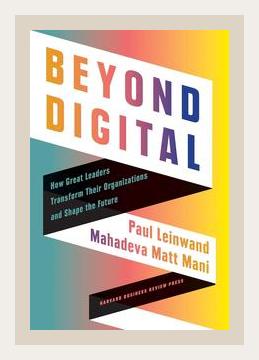Technology and Digital TransformationDigital Strategy
**
I. Introduction
“Beyond Digital: How Great Leaders Transform Their Organizations and Shape the Future” profoundly explores how organizations can move past the conventional digital transformation approach and adopt strategies that genuinely adapt to an ever-changing business landscape. Written by Paul Leinwand and Mahadeva Matt Mani, this book is a critical roadmap for leaders aiming to thrive in the digital era.
II. Embracing a Leadership Reinvention (Chapter 1)
Key Point: Traditional leadership models centered on hierarchical command and control are obsolete. Leaders must now orchestrate an ecosystem of collaboration and innovation.
Concrete Example: The authors cite Satya Nadella, CEO of Microsoft, who shifted Microsoft’s culture from a “know-it-all” to a “learn-it-all,” fostering a growth mindset across the organization.
Action Step: Leaders should promote a learning culture by encouraging ongoing education and openness to new ideas within their teams.
III. Developing Strategic Clarity (Chapter 2)
Key Point: Organizations need clear and coherent strategies tailored to their unique strengths and market demands.
Concrete Example: Procter & Gamble transformed its approach from rudimentary cost-cutting measures to leveraging deep consumer insights to drive growth.
Action Step: Conduct a strategic audit to identify the organization’s core capabilities and align future initiatives with these strengths.
IV. Building a Value-Driven Organization (Chapter 3)
Key Point: A value-driven approach shifts the focus from transactional relationships to long-term value creation.
Concrete Example: Salesforce built a robust ecosystem by prioritizing customer success and value delivery, which in turn fostered loyal customer relationships.
Action Step: Implement a value-mapping exercise in your organization, outlining how each department contributes to delivering customer value and ensuring alignment with broader business goals.
V. Adapting with Innovation (Chapter 4)
Key Point: Innovation should be integral to the organizational DNA, emphasizing experimentation and agility.
Concrete Example: Amazon’s continuous emphasis on innovation, via its ‘two-pizza team’ concept, kept teams small and nimble, fostering innovation and rapid iteration.
Action Step: Create cross-functional innovation teams that are empowered to experiment and swiftly pivot based on feedback and results.
VI. Aligning with Ecosystems (Chapter 5)
Key Point: Strategic alliances and partnerships enhance capabilities and market reach.
Concrete Example: The collaboration between BMW and Intel to develop autonomous vehicles leverages both companies’ strengths, promoting innovation beyond what each could achieve independently.
Action Step: Identify potential strategic partners whose strengths complement your organization’s capabilities and initiate collaboration discussions.
VII. Cultivating a Digital Core (Chapter 6)
Key Point: Digital tools and platforms must be deeply integrated into the organization’s operations.
Concrete Example: The book highlights Alibaba’s use of an integrated digital ecosystem, from e-commerce to cloud computing, which provides a seamless customer experience while operationally linking all of its activities.
Action Step: Conduct a digital maturity assessment to identify gaps and prioritize integrating digital tools that streamline operations and enhance customer experiences.
VIII. Leading with Resilience (Chapter 7)
Key Point: Resilience in leadership involves anticipating disruptions and being prepared to pivot strategies as needed.
Concrete Example: Pfizer rapidly developed and distributed the COVID-19 vaccine by leveraging crisis management frameworks and building resilient supply chains.
Action Step: Develop a resilience plan that includes flexible frameworks for decision-making during crises and ongoing risk assessments to prepare for unforeseen challenges.
IX. Nurturing Talent (Chapter 8)
Key Point: Talent management must focus on developing future-ready skills and fostering an inclusive environment.
Concrete Example: Unilever’s emphasis on lifelong learning programs and inclusive policies ensures preparedness for future challenges and retains top talent.
Action Step: Launch continuous learning programs and ensure diversity and inclusion are core aspects of the company’s talent strategy.
X. Redefining Success Metrics (Chapter 9)
Key Point: Traditional metrics of success, such as quarterly financial performance, must be expanded to include long-term value creation and stakeholder impact.
Concrete Example: Danone’s adoption of the B Corporation certification reflects its commitment to sustainable practices and long-term societal impacts beyond just profit.
Action Step: Integrate ESG (Environmental, Social, and Governance) criteria into performance metrics, encouraging a balanced view of success that prioritizes overall impact.
XI. Enabling Cultural Transformation (Chapter 10)
Key Point: Effective cultural transformation requires embedding the new organizational values into every action and decision.
Concrete Example: Adobe’s “Kickbox” initiative empowers employees at all levels to innovate, fostering a culture of creativity and entrepreneurship.
Action Step: Develop initiatives and tools that empower employees to embody cultural values in their daily activities and decision-making processes.
XII. Sustaining the Transformation (Chapter 11)
Key Point: Sustainable change involves persistent effort, regular reassessment, and continuous improvement.
Concrete Example: The transformation journey of Philips, focusing on health technology, demonstrates ongoing adaptation and strategy refinement over several years.
Action Step: Set up a transformation management office that ensures continuous monitoring, evaluation, and adaptation of transformation initiatives.
Conclusion
“Beyond Digital” provides invaluable insights for leaders seeking to navigate the complexities of a digital-first world. It emphasizes that genuine transformation goes beyond technology, requiring a holistic approach involving strategic clarity, innovation, talent management, resilience, and more. By following the concrete examples and actionable steps provided, leaders can guide their organizations toward sustainable and impactful futures, ensuring they are not only reactive to change but also proactive in shaping it.
Key Takeaways:
- Foster a learning and collaborative culture.
- Align strategy with core capabilities.
- Create long-term value over transactional relationships.
- Embed innovation in the organizational fabric.
- Form strategic partnerships for growth.
- Integrate digital tools comprehensively.
- Develop resilience planning frameworks.
- Invest in talent development and inclusivity.
- Expand success metrics to include societal impacts.
- Facilitate cultural transformation through empowerment.
- Commit to continuous refinement of transformation efforts.
By integrating these principles, leaders will be better equipped to transform their organizations and shape the future effectively.
